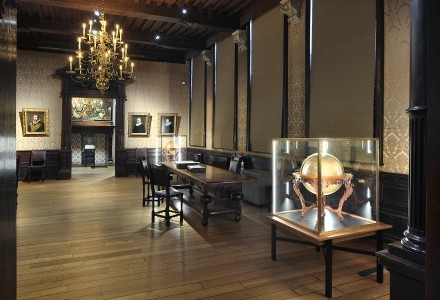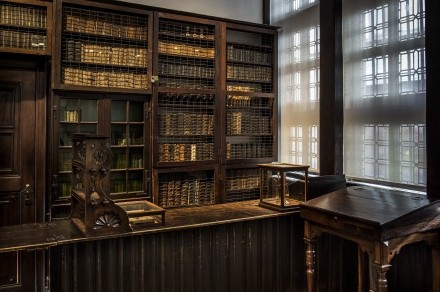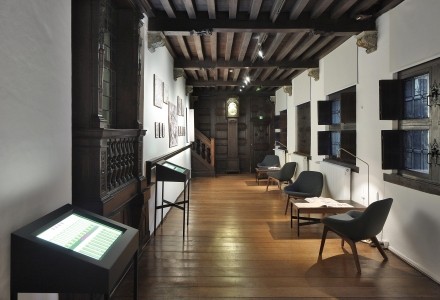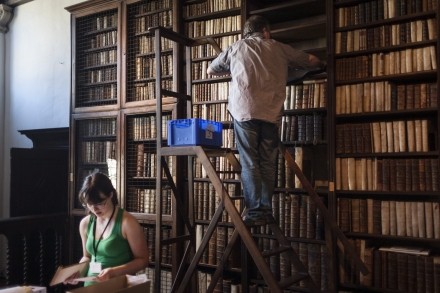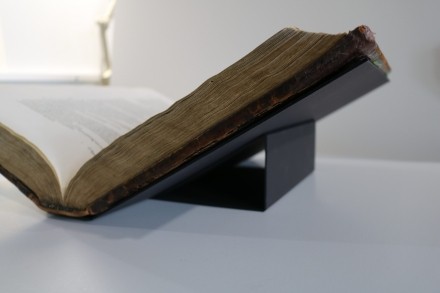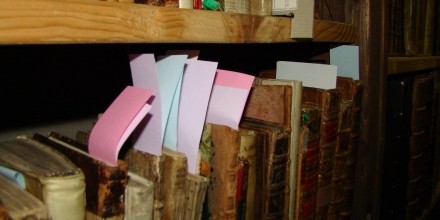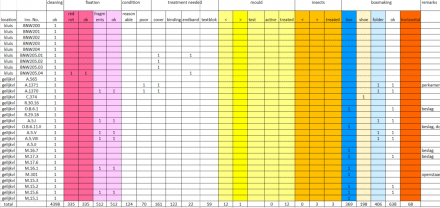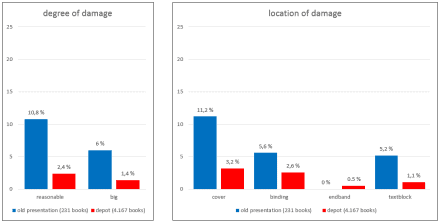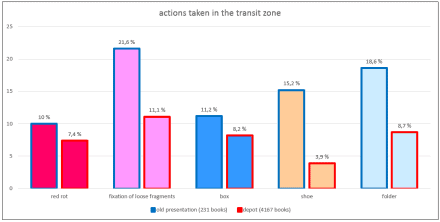Collection care during the transformation of the Plantin-Moretus’s permanent exhibition and actions taken during the historical collections move to a new location
Text of a paper given by Elke Van Herck at the conference of the Association of European Printing Museums, After printing: bookbinding as cultural heritage, Imprenta Municipal – Artes del Libro, Madrid, (Spain), 24-26 May 2018.
Elke Van Herck, Plantin-Moretus Museum, Antwerp.
Introduction
2016 was an important year for the Plantin Moretus Museum in Antwerp, Belgium. A year full of changes. Two major challenges were undertaken. The first the facelift which was given to the museum – more than a facelift really because not only the visual was modified. Besides the structural changes to the entrance hall and auditorium, all permanent displays were changed. The storyline was revamped throughout the museum and the museum experience made more contemporary. Perhaps less visible were an important number of measures taken to protect as much as possible the new presentation.
The second major change was the renovation of two adjacent buildings and the construction of a new reading room and depot.
I will cover mainly the actions that have to do with the care of the collections.
The museum and its collection
The Museum Plantin-Moretus is a historical museum of the ‘printer’ family Plantin-Moretus. Christoffel Plantin, a bookbinder-printer, came from near Tours, France, and established in Antwerp in 1555 his own printing shop, the Officina Plantiniana. This is the beginning of a wonderful journey that will last three centuries. It is one of the largest printing-publishing shops in the Southern Netherlands with at its peak 16 presses in operation, and employing more than 60 workers.
In 1876 the family sold their house, ‘the Golden Compass’, and the printing shop ‘the Officina Plantiniana’ with all of its contents to the city of Antwerp. A year later, the Museum Plantin-Moretus opened its doors to the public. Stylish rooms with gold leather and portraits by Peter Paul Rubens, and impressive libraries show the luxurious atmosphere in which the family Moretus lived. Today the rooms of the ‘Officina Plantiniana’ still show the atmosphere of that time. The museum has a rich collection of 630+ manuscripts, including 116 illuminated medieval manuscripts and top works in the art of printing, i.e. the atlas of Abraham Ortelius (1587), the ‘Biblia Polyglotta’ (1568-1572), and the ‘Cruydt-boeck’ of Rembert Dodoens (1583). An invaluable, almost complete archive of the printer family Plantin-Moretus provides a very thorough picture of how business was conducted at that time.
In 1952, the Print room was included in the Museum Plantin-Moretus.
In 2001, the corporate and family archives, because of their exceptional value, were entered in the list of UNESCO’s Memory of the World, followed in 2005 by the registration of the house and printing office Museum Plantin-Moretus in the list of UNESCO World Heritage.
Part 1: Actions taken during the transformation of the Plantin-Moretus’s permanent exhibition
What should be done after years of presentation?
After years of presentation, there was a need for a fresh new line up. But above all, there was a need for a new arrangement in which the items from the collection were presented with greater care. The old permanent exhibition was fixed, almost literally. For years, the books had been carefully positioned on their support and placed in the display cases where they were minimally lit, often with halogen source. One could not say that the documents were displayed without care, but lack of change for so long had resulted in a slow but certain decay.
Dismantling the display and examining the items
As one of the paper/book restorers of collection-care service of the city of Antwerp, my involvement in the project to provide the museum with a new permanent exhibition in October 2014 was timely. My colleague restorers of wood and paintings, the team of art handlers, and the collection care designers also helped with this transformation. All the galleries and all the objects in the halls were going to be affected, and because many hands make light work, a large number of museum staff, volunteers and student employees (with or without a background in conservation-restoration) were mobilised.
In February 2016, we started with the dismantling of the existing presentation. Paintings were taken to the restoration workshop just outside of the city of Antwerp to assess their condition and to perform the necessary interventions. Framed and loose prints or printed material were handled in situ or in the restoration workshop located in the museum. All the cabinets were opened and books were taken out and also transferred to the Museum’s restoration workshop. Very quickly was established that the books and works on paper had suffered substantially from their long-term presentation. Framed prints sometimes had a very high level of acidity as acidification originates from prolonged exposure to light, and can be caused by an non-archival framing. The organic material felt very dry. The folios that had been exhibited were dried out and had started curling up a little at the edges. Dust had slowly entered into the display cases and formed a fine grey, somewhat greasy layer on the exposed sheets. When closing the books, you could feel the tension building up in the binding structure. And some books did not even close anymore. others, mainly vellum bindings, spontaneously opened to the pages that used to be displayed, showing how they had faded.
Treatments of pieces of the old permanent exhibition
The items from the permanent collection (231 books and more than 31 framed prints or printed material) received conservation treatment only because they returned to the depot. All the books were first dry cleaned, folio by folio. For this purpose, a vulcanized smoke sponge was used. Locally, a pencil eraser was used in order to take away the dirt that had penetrated into the paper fibers. The open books with tension on the back structure were relaxed by placing them in an environment with higher humidity. An ultrasonic humidifier was put in a small humidifying dome and the books were placed inside. Organic material, which is hygroscopic, absorbs moisture naturally and through this absorption of moisture the material becomes flexible and elastic. By gradually increasing the pressure on the binding, the book structure is closes with increasing ease. Of course, this must not be done too abruptly, because doing so may break the hinges. And it does not succeed entirely with books that have been opened too far or whose back is strongly crimped or weakened. The books were then checked for loose fragments, weak zones, cracks and gaps. The repair of this damage was mostly carried out with Japanese paper, which may or may not have been given a tone/color with leather dye in order not to have the ‘conservation-surgery’ interfere with the visual characteristics of the displayed item. Usually, a Japanese paper with Kozo-fiber 6 or 10 grams was used. Depending on the degradation, it was applied to the folios recto-verso, or applied in several layers. I prefer to use multiple layers of thin Japanese paper because of the flexibility. This manipulates better and therefore adheres better to an irregular structured layer. As an adhesive, we used a starch glue, on the basis of wheat, and a methylcellulose adhesive (Tylose MH300P). The leather of many books was acidified and pulverized at the hinges, at the edges and on the back. To put a stop to this pulverization, or “red rot”, we used a hydroxyl-propyl-cellulose adhesive dissolved in alcohol (Klucel G 2% solution in a 20/80 mixture of water-isopropanol). After the conservation treatment was done, the fragile books were stored in boxes made of corrugated museum card board (phase or four-flap box type) to better protect them in the depot.
The prints from the permanent exhibition were stripped of their assembly, followed by a dry cleaning with smoke sponge or granulated Eraser (natural rubber or vinyl-based). Depending on the degree of degradation of the paper they were cleaned more thoroughly and de-acidified by a wet treatment with ‘Paraprint OL60’. Paraprint is a synthetic fabric with strong capillary action. It sucks moisture including the moisture-dissolved dirt and acid out of the paper. It also reduces visible discoloration. We noticed that paper that underwent treatment via Paraprint, had better atomization, looked fresher and had more flexibility. The organic material was dried out. So the moisturizing revived the paper fibers. Cracks and small gaps were repaired with Japanese paper (Kozo fiber, 6g), recto-verso with methylcellulose glue (Tylose MH300P) or starch glue (wheat starch). After the conservation treatment followed the flattening, the mounting on a non-acidic carrier (museum mounting board), and the necessary protective folders or covers with an acid-free paper were added, before returning to the depot.
The new permanent exhibition
Given the findings established during the dismantling of the old permanent exhibition, we needed to improve the new arrangement.
A new structure, new types of galleries
To bring the house more alive, the historical areas, museum and relaxation spaces were separated in order to better enjoy the collection. Period rooms, including those decorated with gold leather, the libraries, and the lounges filled with display cases, had lost their glory and were only areas where books are presented. In the new setup, we wanted to again draw attention to the beauty of these areas, because these areas are a story in themselves. Therefore no display cases to show books or works on paper were placed in these rooms. They are now showcased under the heading ‘historical areas’. To enhance the character of the building and the display areas, all cabinets, tables, chairs, carpets, glassware, pottery, silverware and other objects of wood, metal, etc… that did not date from the right period or were not related to the family were removed and stored in the depots. In the ‘museum’ rooms, where the cabinets are, you find the presentation of books, prints, and printing material. It is important to give people a better feeling with the house or the collection. An example of what we have done in the new setup is that people can now consult a facsimile per theme. They not only see the presented folios, but more of what a book in the display has to offer with regard to content. The book structure of the facsimiles resemble those of old books. The leather bindings have a fixed back and ribs, but with a modern touch. In the relaxation rooms you can take a break and look into some of these facsimiles and you can also explore the collection using a digital library.
Measures for improved presentation
Being responsible for this UNESCO world heritage and as heir of this important publishing family Plantin-Moretus, we have to pay close attention to the preservation of the collections in the new permanent exhibition. Because prolonged presentation of objects is always harmful, a number of measures were taken so as to minimize the potential damage caused to the objects on display.
First, the choice was made to no longer present the books and prints that had been displayed for years. Let them rest. This also included some major works (‘City map of Antwerp in Birds eye view’ Virgilius Bononiensis 1555, ‘Wenseslas Bible’ Prague 1403). The new storyline in the museum must therefore be strong enough so that these works would not be missed.
Books and prints are now replaced every two years. For the most fragile pieces the folios are turned after 3 months. Exceptionally the items (e.g. charters) are replaced after three months with a reproduction. The use of reproductions will however be limited. The use of replacement pieces, that facilitate the preservation of the documents, make it necessary that they also be in the storyline. This is not easy. The museum has several copies of some works, but it is not always possible to find a replacement for each piece. Possibly, at the next changeover, scheduled for October 2018, there will be a few reproductions displayed. Alternatively, replacements, on loan from the Heritage Library Hendrik Conscience in Antwerp, will be used.
A third measure for the care for the cultural heritage has been to greatly reduce the number of display cases used in the current setup. There were an equivalent of 60 single display cases removed. However, the old cabinets that were historically part of the museum were reused. The least suitable display cases (which usually are the most shallow ones) were removed. The other display cases were reused and were all checked for stability, visual damage such as scratches, safety and in some cases were deepened. Using deeper showcases, means that the books do not have to be opened so wide and with the result that there is less stress on the book structure. We hope that there will be fewer books that will not close properly at the end of their period of presentation (two years). In addition to the re-use of old display cases, there are a 4 new display cases.
The number of books being shown is now 125 where previously 231 books were displayed. However, there are now more prints on display (57), and printing material such as woodblocks, copper plates, sets of types (58), which are used not only to illustrate the story, but also because they have traditionally been mainly stored in the depots and merit greater public attention. Overall, the numbers of books, papers and prints was reduced from 261 to 182. On the one hand this choice was made to subject the works less to the adverse conditions of presentation, and on the other to offer an arrangement in which the art and the historical home of the family Plantin-Moretus is now more apparent.
Consistent with dividing the museum into types of rooms (historic rooms, museum spaces and places to relax), was the question of reducing light levels in the rooms. It was decided in the historic rooms with homely character to hang custom colored drapes which provide full blackout and reduce temperature.
In historic rooms with less homely character, a half-transparent blind was used to obtain proposed light and lux standards.
In the museum spaces, where books, prints and drawings are shown, a complete blackout is obtained through the use of white blinds. In order to maintain the link with the historic courtyard we elected to place in the relaxation rooms, where no original books or papers are shown, UV-filtering and temperature-reducing glazing in front of the stained glass windows.
Taking into account the seasons and sunlight we made sure that, in case of too excessive light levels, the wooden shutters of the windows can be closed in order to maintain proper light and lux standards at all times. In addition we also took into account the orientation of the rooms, so that the south-facing windows provide sufficient darkening.
We changed the lighting to LED. This allows to clearly see the objects with less intensity and completely excludes the harmful radiation.
In addition to light, we also considered temperature and humidity fluctuations. In a historic building, one always has a hard time achieving the required levels of temperature and humidity. The space above the gallery was climatically the least stable with large fluctuations. This space is now transformed into a relaxation room. Hence, there are no original documents shown. Another difficult zone to control is the direct exit of room 3 onto the garden. There is now a leather curtain attached on the outside. This way we hope to minimize the largest fluctuations in room 3.
The cleaning operation
Because the new presentation is also intended to refresh the museum, we updated literally everything. Everything was dusted – an absolute necessity. The content of the three library spaces and the historic bookstore of the museum were given a good cleaning. A total of 10.651 books! From January 2016 till opening in September the upper floor was closed, and from May till the opening of the new presentation the whole museum was closed. During that time a team of volunteers and museum staff did almost nothing else dust! Everyone worked in teams of 2 or 3 people with vacuum cleaners, wipes, brushes… The books, were only cleaned on the outside, but if dust had entered the inside, then of course the inside was also dusted.
Because most of the staff had no background in handling books, a speed course was given in cleaning museum objects. For books with clear signs of damage we recorded whether the damage was serious or reasonable and where the damage was located – cover, binding or text block – with the aim of including them in the list for future external restoration projects. With regard to biological damage, I was called in to evaluate the impact and to intervene if necessary. Fortunately there was almost no damage of this type.
But simply removing the dust already works wonders. Not only is it better for the books because dust can be a carrier of fungi and harmful gases, but the books also look much fresher. You could tell where the team who did the cleaning had already been active because the books were all neatly put back on the rack. There was just enough time for each book, each painting, each image and each piece of furniture to be dusted. Everything not only looked very clean at the opening, it actually was!
Handling the books, prints and other printed matter of the exhibition
At the beginning of 2015 we started reviewing and processing books for the new presentation. Although the books from the depots were significantly less polluted than the books that came from the permanent collection, they were also dry-cleaned folio by folio. The books were checked for cracks, weak zones or loose fragments. The strength of the binding was verified as well as the flexibility of the cover.
Given the scale of this operation and the fact that I was the only paper-book restorer present, assisted by some volunteers and students with a background in restoration, only essential conservative treatments were carried out to ensure that the books were rendered stable. Most treatments were done with Japanese paper. In order not to make the repairs immediately visible, the Japanese paper was colored. Time did not allow us to restore the leather. Books with major damage, with a need for treatment of the leather e.g. repair of broken and partially missing backs, were outsourced to external restorers.
Making supports
We also made new supports for the books on display out of black archival card board. To make them minimally visible, we adapted our standard book support design. The books themselves are completely backed with cardboard, minus a few mm at the edge (so that the stand under the book does not show). This board was then mounted on a smaller stand. This way the book gets its full support, but the structure underneath the support is much smaller and less visible. Sometimes the books seem to float in mid-air.
Treatment of prints, printing material and assembly
A selection of prints and printing material was checked and treated where necessary. To the prints without a white border an inlay was applied, so they could nicely fit into the passe-partout and could be mounted against the mounting board. Prints with an original edge from the papermaking process were framed without a passe-partout. Most prints or printed material were mounted and framed. The frames were adapted in sized and depth to the object. Materials used: wooden frame of walnut, clear glass antiglare and UV protection 48%, passe-partout board and mounting board in conservation board, backing board of frame in an alkalis corrugated board.
Evaluation of the new presentation
Climatically
During its fhe first year we regularly evaluated the condition of the permanent collection. We checked if the light values stayed within range and for the zones using UV-resistant glass and open shutters to view the courtyard, and if we needed a summer and winter regime by opening and closing the wooden shutters. On the basis of our findings taken during the first year this was not required. During the summer months, as well as the winter months, the values remained below the set norm.
However, there was a problem with the gold leather trim in the area 1, on the window side (day side). How to protect the gold leather even better here? The light levels in the room, and especially against the leather on the day side, were too high. Here, on the inside almost against the windows we have placed a white Museum art Foam, hidden behind the curtain which now keeps the light intensity within the norm.
Does the set up remain stable?
Are the books still displayed correctly? Does the new design of book support sufficiently support the books? Everything seems to work well. Although we have taken action to handle the items with the utmost care, I will be very curious to see in October 2018, when the first change of the permanent collection is planned, if the books will close smoothly, if there has been a lot of dust infiltration, and if we will have to repair new damage to the books because of the new presentation.
After the opening we almost immediately started to treat the replacement items for this autumn. Currently we are doing the latest treatments. Then we still have to mount the prints and other printed matter as well as making the book supports. There are currently six volunteers active in this phase, amounting to an equivalent of one full equivalent employee. All of them are under the supervision of a conservator.
Because not all the volunteers have the same background – some are literally beginners – and because we try to have all the work go smoothly, we have set up a ‘conveyor system’. First of all the books that need major treatments are placed in a separate container for ‘external restoration’. At the beginning of the conveyor system we have a box with the still untreated books. We take the most inexperienced volunteers to dry clean these books with a smoked sponge and soft brushes. After cleaning, the books are placed in another container, ‘minor procedures’. Volunteers who control the process take care of small repairs of cracks or loose fragments or the treatment of red rot. When the books are completely repaired, they go to a box ‘return to depot’. But, if the books cannot be completely treated because the damage is too great or complex, they are moved to another container to be treated by the most experienced staff. After treatment they also are put in the container ‘return to depot’. Here they wait for the book supports to be made.
For prints and printing material a similar process was started. The items, are moved from one folder to another every time a particular treatment is performed. For example, the folders are entitled ‘untreated’, ‘disassembled ready for cleaning’, ‘old assembly cartons’, ‘small and inlay treatments’,’ major operations’ and ‘ready for assembly’.
The big change from 2016 is that the museum was at that time closed to the public for several months. Now, in the autumn, the change of the presentations will be gradual. During the weekly closure of the Museum, the items will be changed, one room after the other.
Part 2: Actions taken during the move of the collections to a new location
A new depot
Besides the total overhaul of the exhibition presentation, the Museum also acquired a brand new depot and reading room. The new depot has room for just over 1.8 km shelves, and 618 in-plano trays and is equipped with the most modern techniques.
The following collections are now stored in the new depot: the archive of the ‘Officina Plantiniana’; 638 manuscripts from 9-17th century; 155 incunables; the production of the ‘Officina Plantiniana’ with 68,000+ printed folios, 11,000+ bound and printed works from the 16-18th centuries; the collection of roughly 21,000 old prints and 2,700 drawings; modern drawings and printbooks; sketchbooks.
The fact that the collections are now stored in a climate-controlled area is an improvement in itself. The moving to a new depot also involved looking for better ways to store of the items on shelves or in drawers. So we had to decide how many shelves were needed, taking into account the collections, the formats and whether the books are to be placed vertically or horizontally. We looked at the new location where the collections were to be placed and considered whether they could be moved without change or if adjustments should be made and whether the books would be in the same order as before.
We obviously wanted the books to enter the new depot free of dust. We also needed to make sure certain fragile books were protected and allow weak structures or large volumes to lie flat. The collections that moved to the new depot were first screened. Given the timing, the extent of the project and the available staff, it was not possible to do a comprehensive condition report for all the books and other items in the collection that were to be moved. It was important to get a good view of the general condition of the collection and to note what interventions the books should undergo before entering the new depot. Two people reviewed the books, one by one – a particularly interesting job because it allowed us to encounter first-hand the real gems of the collection. One person took the book, decided what the damage was and then put coloured paper strips into it.
This colored strips refer to the actions to be undertaken before the book could be put in the new depot. A second person recorded everything in an excel spreadsheet and in doubt asked the other person to review. In case of damage, it was only noted where the damage was located (cover, binding, end band, text block) and whether the damage was severe or not. Minor damage was not recorded. This gave only a first indication of the state of the collection, but it could be used to determine what works needed urgent treatment and which ones should be included in the list of books for external restoration.
Actions included in the screening
1. Preventive and active conservation interventions
- Fixing of loose fragments and weak areas with Japanese Paper.
- Fixing red rot or powdered leather with a cellulose glue (hydroxyl propyl cellulose Klucel G, 2% solution in a 20/80 water-alcohol (isopropanol) mixture).
2. Actions related to biological damage
- Mold damage.
- Insect damage.
Books with this type of damage were placed in quarantine, in particular because one first needs to know the extent of the damage to in order to be able to determine the appropriate treatment. If there are only a few books affected and if the damage not too serious, we can handle these ourselves internally. If too many books were damaged or seriously deteriorated, we had to divert to techniques that can handle larger scale action.
3. Actions related to storage
- Provide wrapping.
- Provide storage cases. Criteria for this are books with metal or locks or books in poor condition.
- Store flat in depot.
Before going to the depot, the books were put in a transit zone after screening. A team of volunteers, some with a background in restoration and bookbinding, who took these books to heart. On the basis of the colored strips placed in the books, they knew what actions to take. They took care of the repairs and some of the folders and storage boxes.
We expected to find only orange strips in the books when they entered the depot, referring to horizontal storage. However a series of dark blue strips, referring to box-making, remained. Not all storage boxes could be made in time. This project is still being continued today by volunteers. Currently the books that need another box because of their poor condition, are protected by a paper wrapper and placed in the depot. Books with metal are placed in the depot with two acid-free card board sheets on either side of the book.
It is perhaps important to mention that the process of emptying the old depots gradually created a major climate change. Books act as a buffer to fluctuations in humidity, and this buffering effect was reduced as the number of books present diminished. In depot 1 for example we experienced excessive humidity. The last books were especially affected and a small fungal attack was detected. Once we realized this was happening, we placed the remaining books in quarantine and treated them.
Closing remarks and conclusions
2016 was a very active year for the museum Plantin Moretus, with the new museum set-up in which, in addition to the care of the collection, atmosphere and experience have a central role. To have a set up in which objects are replaced after two years, preparation work is never-ending (finding replacement objects, preparing them for presentation). A major project like this affects the planning of the staff in their daily work over a long period.
Just doing minor treatments, such as cleaning, works wonders. Cleaning requires time, but in addition to providing clean objects, it also gives an idea of the general condition of the collection, detects hidden danger (like biological damage) so that further action can be taken. It offers an opportunity to place the objects, well supported on their shelves, and gives visually a much better look.
If the project is too large, you can’t do everything you want. You need to make decisions in how detailed the treatments will be.
We had so many construction projects: the transformation of the entrance hall to better accommodate the public; the design of the new depot and reading room to store the collections better and to bring them closer to the reading room for consultation and research as well closer to the new restoration workshop. In the past, the latter was not located in the most ideal location in the museum, in terms of climate or of accessibility. Collection items had to travel through the museum with the visitors present, from the depot to the restoration area. Today our workshop is well located next to the depot and close to the reading room. Also the climate is much more favorable, a huge advantage.
Because not everything could be moved at the same time and because the planning of one renovation job did not line up with the next one, the operation involved extra moves.
Since the changes, the renovation of the Plantin-Moretus museum has already received several national and international nominations and prizes for the entire renewal project.
And if, in October this year, we are able to confirm that the new presentation did not affected the objects, we will be finally completely happy.
Elke Van Herck
restaurator of paper and books
Collection care
City of Antwerp
elke.vanherck@stad.antwerpen.be
